Now, the U.S. special forces have a new secret weapon cell phone jammer aimed at the insurgents. It is lightweight, relatively quiet and very effective, and is called the “Bumblebee Project.” Imagine having to attack a rebel warehouse deep in enemy territory. Remember, the weakest link with the enemy is communication.
The possibility of disrupting this communication should also be considered, whether it is a cell phone, walkie-talkie or other two-way radio and GPS signals. In fact, anything within sight-including the sight of the entire city-can be effectively blocked. Although the details are still scarce, some information about the previously unknown “Bumblebee Project” has been released in the relevant Pentagon budget documents.
According to a report in Forbes magazine, this is what we know. In the R&D budget of the Interagency Office of the Secretary of Defense, the “Bumblebee” project is described as an “advanced manual launch drone system” that can be deployed by personnel to interfere with enemy electronic capabilities to disrupt the competitive environment. . ”
In short, this is a small manually launched drone that can interfere with electronic signals and can be used on friendly aircraft that are not easy to operate. In this case, special forces may need to carry their own air force. According to Forbes, the US Special Operations Command operates hundreds of small tactical drones, from palm-sized helicopters to quadrotor helicopters to large fixed-wing drones, and uses them extensively to collect information.

They are also the main users of SwitchBlade portable tubular launch strike drones. Adding cell phone jammer to the mix is a natural extension of its capabilities. According to Forbes, one possible platform is the widely used RQ-11 Raven, a miniature aircraft that weighs 4 pounds and has a flight time of up to 90 minutes.
The document states: “The UAS platform, together with service and cross-agency partners, provides special operations forces (SOF) with a universal and adaptable function that can be applied to various electronic adversary threats.” Although the most obvious The purpose is to interrupt communication, but it is clear that the Hornet plan can do more. Small drones can also interfere with or forge GPS. According to Forbes, a drone jammer of the same size and power as a smartphone can bring any GPS into the field of view.
Special forces may also be interested in using drone jammers to disable enemy radars. According to experts, small drones launched from the command can be very close to the radar, and nearby mobile phone jammers can provide more than ten kilowatts of power from a manned electronic aircraft at a safe distance.
The information provided indicates that the system has successfully “demonstrated” its functions, adding that the project has been “converted” to the Special Forces Command and is awaiting assignment to the U.S. Army Special Forces. There does not appear to be a further reference to the project, and the document states: “More details of this project have been categorized.”
According to Robert Bunker, an analyst at C/O Futures, LLC, special forces may have a great demand for this feature. Bunker said: “One of the electronic warfare drones can place itself above a terrorist or insurgent warehouse to electronically isolate it before an ambush.”
“Drones can be used to electronically isolate and suppress specific targets in tactical bubbles.” He also pointed out that cell phone jammers can be used to prevent the spread of drones dropped by grenade used by insurgents and others. Bunker said: “A convoy can activate one of the systems in anti-UAS mode to eliminate enemy drones with weapons.”